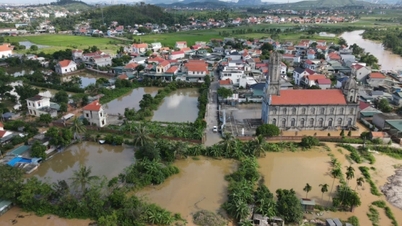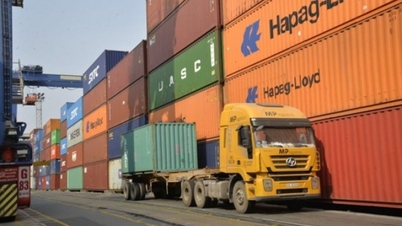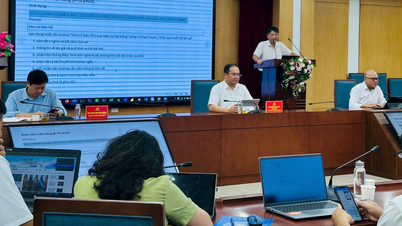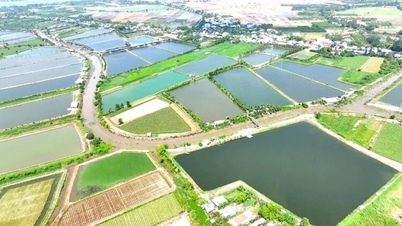In June 2024, foreign press opinion positively assessed Vietnam's economic development situation. Accordingly, Vietnam's economic prospects are still assessed to be optimistic; Vietnam is a rising star, a bright spot in Southeast Asia and a connected country, and is also assessed to be becoming a digital hub.

GDP growth remains positive in the coming time
Foreign media and press analyzed a number of difficulties and challenges of the Vietnamese economy, emphasizing that global trade growth has slowed down due to high energy prices and prolonged inflation, negatively affecting the Vietnamese economy, which relies on exports and production.
However, in general, foreign press has positive comments on Vietnam's economic development situation, accordingly, Vietnam's economic prospects remain positive, with growth forecast to reach 4.5%-6% in 2024 and 4.7%-7% in 2025.
Specifically, Oxford Economics forecasts GDP growth of 5.6% in 2024, while United Overseas Bank - UOB (Singapore) forecasts growth rate of growth Vietnam's economy is expected to grow by 6% in 2024 and 6.4% in 2025.
Maybank Research forecasts Vietnam's GDP growth to recover in 2024 and 2025, at 4.5% and 4.7%, respectively, compared to 4% in 2023, while ING THINK forecasts Vietnam's GDP growth in 2024 at 6%, one of the highest growth rates in the region, and is expected to increase to 6.5% in 2025.
&P Global Ratings Vietnam's economic outlook remains positive, with real GDP growth at 5.8% in 2024 and returning to the long-term trend of 6.5-7% in the next 3 to 4 years.
Both exports and imports are likely to return to steady growth in 2024. The current account surplus will remain high, at around 5.5% of GDP in 2024, before declining in line with the long-term trend from 2025.
The macro economy is stable and increasingly diversified, with a booming manufacturing sector, largely driven by FDI. Vietnam remains an attractive destination for foreign investment, particularly in the manufacturing sector, as businesses continue to diversify their operations across the region.
Vietnam as an attractive FDI destination in Southeast Asia thanks to its young, increasingly educated and competitive workforce, which will help sustain long-term growth.
The increasingly complete export logistics network makes the manufacturing industry attractive to global corporations in the electronics, mobile phone and textile industries.
FDI-invested industries continue to boost domestic activity, with better job opportunities and higher wages, thereby boosting personal consumption growth.
The semiconductor industry growth cycle is also expected to boost Vietnam's growth in 2024 as semiconductor exports increase.
In the services sector, cross-border tourism is recovering, with a surge in Chinese tourists. Domestic demand is also recovering, although still slower than GDP growth. Public investment is likely to accelerate gradually in the coming years, mainly from the state budget.
Vietnam is a rising star, bright spot in Southeast Asia and is a connected country.
The website of the Goyang city government, Gyeonggi province (South Korea) assessed that Vietnam is a rising star in Southeast Asia.
Vietnam, known as an emerging economy in Asia, has developed into the world's 35th largest country in terms of gross domestic product (GDP) and the world's 26th largest in terms of purchasing power parity (PPP) by 2023 (IMF statistics).
GDP per capita is about 4,300 USD, equivalent to about 14,000 USD in PPP. This is a far cry from the figure of only 1,200 USD when Vietnam began its reforms. Vietnam has now become a medium-sized economy and a lower middle-income country in terms of income.
As economic reforms progressed, Vietnam’s economic system also changed. Its industrial structure became a typical model for developing countries.
Vietnam has had a trade surplus since 2012 (except 2015). This is mainly due to the exports of foreign-invested companies. FDI companies also play an important role in other manufacturing sectors. Foreign direct investment has continued to increase as Vietnam has implemented reform policies, especially since 2006, before Vietnam joined the WTO.
As Vietnam's economy develops, not only FDI companies but also domestic companies are becoming more and more competitive.
The most important issue now is the global supply chain of high-tech industrial products such as mineral raw materials such as rare earths, electric vehicle batteries, semiconductors. Vietnam is also trying not to fall behind in the high-tech industry.
In addition, Vietnam also makes efforts to foster IT human resources by attracting IT centers of world-class companies to Vietnam.
Meanwhile, CNBC (USA) quoted the opinion of Mr. Kai Wei Ang, ASEAN economist at BofA Securities Inc. Vietnam remains a bright star in Southeast Asia, despite last year's power shortage and weakening real estate.
Mr. Kai Wei Ang emphasized that Vietnam and ASEAN are clearly the biggest beneficiaries of the “China + 1” strategy. Southeast Asia is the natural choice because of its proximity to China. Vietnam’s advantages in terms of a competitive labor market and a series of FTAs make exporting to other markets such as the European Union much easier. These advantages provide the fundamental support for Vietnam to attract investment.
Vietnam is also seen as emerging as a digital hub, driven by dynamic collaboration between global investors and local tech innovators.
According to the rankings, Vietnam ranks second in digital economic development in the world. The World Bank believes that Vietnam's digital economy is expected to exceed 43 billion USD by 2025 thanks to the continuous focus on promoting information and communication technology, including AI integration initiatives.
An increasingly high-quality workforce is one of many factors helping Vietnam emerge as an attractive destination for business innovation.
The government has introduced a series of initiatives and policies to boost IT education and training. Vietnam has 57,000 IT graduates each year, among the highest in the world.
Semiconductor manufacturing is another area that is growing strongly in Vietnam. US investment and deeper relationships with major corporations such as Microsoft, Nvidia and Marvell have put Vietnam in a position to play a major role in the industry in the coming years.
Source






![[Photo] Binh Trieu 1 Bridge has been completed, raised by 1.1m, and will open to traffic at the end of November.](https://vphoto.vietnam.vn/thumb/1200x675/vietnam/resource/IMAGE/2025/10/2/a6549e2a3b5848a1ba76a1ded6141fae)





























































































Comment (0)